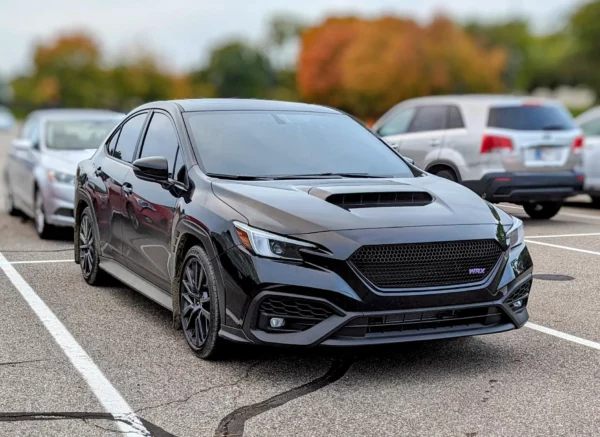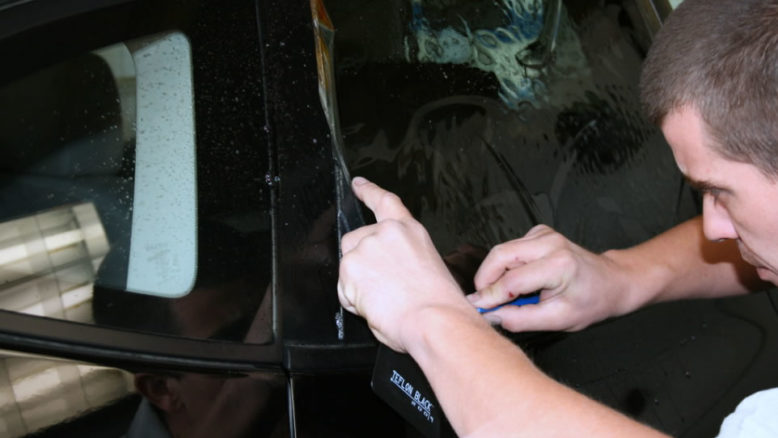Tinting your car windows is a great way to keep the sun out of your eyes and prevent glare. But tint film is also a great way to improve the appearance of your vehicle. There are many different types of car tint film available. In this article we’ll explore what they all look like, as well as how they can affect the performance and safety of your vehicle.
Quick overview:
- Dyed Window Tint Film:
- Dyed window tint is a basic dyed film that provides lowest level of heat rejection and glare reduction.
- It is one of the most affordable options, and is mainly used for basic privacy reasons.
- Metalized Window Tint Film:
- Metalized tint contains tiny metallic particles that reflect sunlight and heat away from the vehicle.
- It offers good heat rejection and can add a shiny appearance to the windows. However, it may interfere with electronic signals like cell phones or GPS devices.
- Carbon Window Tint Film:
- Carbon window tint is a premium option that uses carbon particles to block infrared light and reduce heat.
- It provides a sleek appearance due to its matte finish, with substantial heat reduction.
- Ceramic Window Tint Film:
- Ceramic tint is considered one of the best options for heat rejection and UV protection.
- It offers exceptional clarity and heat reduction, but is usually most expensive.
Window tint film comparison:
This table provides a quick comparison of dyed, metalized, carbon and ceramic tint film.
| Factors: | Dyed | Metalized | Carbon | Ceramic |
|---|---|---|---|---|
| Heat Rejection | 1/5 | 2/5 | 3/5 | 4/5 |
| UV Rays Blocked | 1/5 | 3/5 | 4/5 | 5/5 |
| Fading | 1/5 | 3/5 | 5/5 | 5/5 |
| Durability | 2/5 | 3/5 | 5/5 | 5/5 |
| Glare Reduction | 2/5 | 4/5 | 5/5 | 5/5 |
| Scratch Resistance | None | Medium | High | High |
| Price | Low | Medium | High | Highest |
Please note that the ratings are relative and can vary based on the specific brand and product within each tint category.
Dyed window film
Dyed car window tint film is one of the most commonly used options for enhancing privacy and reducing sunlight in vehicles. This type of tint is composed of a layer of dye sandwiched between an adhesive layer and a polyester film. Dyed tint is known for its affordability, making it a popular choice among car owners looking to improve their vehicle’s aesthetics and comfort at the smallest price tag.
One of the primary benefits of dyed window tint film is its ability to reduce glare and block a significant amount of visible light, which can make the interior of the car more comfortable and cooler. However, it’s essential to note that dyed window tint’s UV protection and heat rejection is nowhere near as effective as other types of tint films, such as ceramic or carbon.
Despite its affordability, dyed window tint has some drawbacks. Over time, the dye in the tint may fade or discolor, potentially reducing its effectiveness. Additionally, dyed tint may not be as durable as other options, and it can be prone to scratches.
Dyed window film also frequently comes in various colors. But, most U.S. tint laws prohibit using colored vehicle window tint. For details on this you should check your state laws carefully, as we have the information on restricted tint colors for every state.
Ultimately, dyed car window tint is a cost-effective choice for those seeking basic privacy and glare reduction, but it may not be the best option for those looking for superior heat rejection or long-term durability.
Metalized window film
Metalized car tint film is a popular choice for those seeking a combination of style, performance, and durability in their vehicle window tinting. This type of tint contains tiny metallic particles embedded within the film’s layers, providing a distinct appearance and a range of practical benefits.
One of the significant advantages of metalized tint is its superior heat rejection capabilities. The metallic particles reflect and absorb a substantial portion of the sun’s infrared radiation, helping to keep the car’s interior significantly cooler. Additionally, metalized tint offers increased UV protection compared to dyed film.

Applying Tinting Film (Photo by Michael Sheehan)
Its robust construction makes it more resistant to wear and tear, and it is less prone to fading compared to dyed tint. However, there are a few drawbacks to consider. Metalized tint can interfere with electronic devices like GPS, cellular, and radio signals due to the metallic content. Additionally, it tends to be more expensive than dyed films, which may be a factor for budget-conscious consumers.
It’s crucial to remember that nearly every state has tint laws prohibiting metallic or reflective appearance, either completely or up to a certain degree of reflectivity. Consult our laws to learn the regulations for your state.
Carbon fiber window film
Carbon window tint is a premium choice for those looking to combine style with exceptional performance. Composed of carbon fiber particles, this tinting option stands out for its durability and UV resistance. One of its standout advantages is its resistance to fading, ensuring that your tint remains visually appealing over time, unlike dyed tints that will degrade over time.
Carbon tints are highly effective at blocking the sun’s rays, surpassing the performance of both dyed and metallic tints. Moreover, the matte finish of carbon tint is preferred by many for its aesthetic appeal, giving the vehicle a sleek and modern appearance.
In addition to its visual and UV-resistant qualities, carbon window tint offers remarkable insulating properties. It significantly reduces the heat from the sun by up to 40 percent, which enhances driving comfort and can lower the need for excessive air conditioning.
However, it’s worth noting that carbon tinting tends to be more expensive than other tinting products due to its superior qualities. Despite the initial higher cost, its durability and long life expectancy make it a worthwhile investment.
Ceramic window film
Ceramic car window tint stands as the undisputed champion when it comes to window tinting, offering an impressive array of benefits. Boasting the ability to block over 99 percent of harmful UV rays, ceramic tint sets the gold standard for sun protection. Its composition is free from dyes or metal particles, ensuring that it won’t fade over time or interfere with radio signals, addressing common drawbacks associated with other tinting options.

15% VLT side windows and 55% VLT windshield ceramic tint. Photo credit: ShadowedRepercussion
The key advantage of ceramic tint lies in its ability to provide top-tier insulation. By not conducting heat, it effectively reflects sunlight while significantly reducing the impact of heat on the car’s internal temperature, making it the best option for heat rejection. Ceramic tint has 50% to 70% heat rejection, with high end nano ceramic film even higher.
Furthermore, it enhances safety by fortifying windows, similar to metallic tints, but with the added benefit of glare reduction without the need for an excessively dark tint. This means you can opt for a lighter shade while still enjoying substantial glare reduction.
However, the one downside to ceramic tint is its cost. As the premium choice among tinting options, it comes at a higher price point, making it a more substantial investment in comparison to other products.
Other tint film types
Crystalline Window Tint Film:
-
- Crystalline tint, often produced by 3M, is a high-end transparent film that provides exceptional clarity and UV protection.
- While it may not provide as much heat rejection as ceramic tint, it is known for its almost invisible appearance, making it suitable for additional UV protection without darkening windows.
IR (Infrared) Rejection Tint:
-
- These tints are designed to specifically block infrared rays, which are responsible for heat.
- They are effective at keeping the interior cool but can be more expensive.
UV-Reflective Tint:
-
- UV-reflective films are engineered to block a high percentage of harmful ultraviolet (UV) rays.
- They don’t provide significant heat reduction, but are excellent for protecting the interior and occupants from UV damage.
Privacy or Dark Tint:
-
- Dark window tints primarily focus on privacy by making the windows nearly opaque from the outside.
- They may not be legal in all jurisdictions, so it’s essential to check local regulations before applying them.
Tint films come in different types, each with their own unique benefits.
There are a variety of ways to choose your tint film. In most tint shops you can either choose a dyed, metallic, carbon or ceramic tint film. Each type has its own unique benefits as well as different levels of darkness and sizes available for purchase.
But the most important thing is to choose one that suits your needs and budget. If you’re not sure about what type of film to buy, visit a professional tinting business and ask them for advice. Most will be happy to give you a rundown and provide examples of their work.




